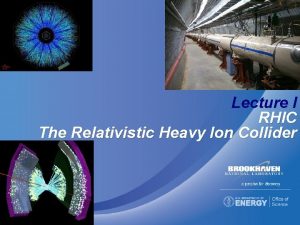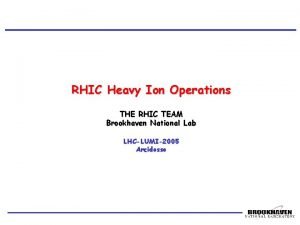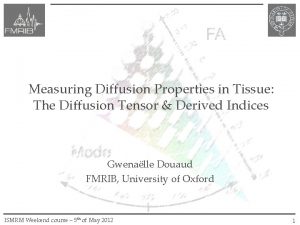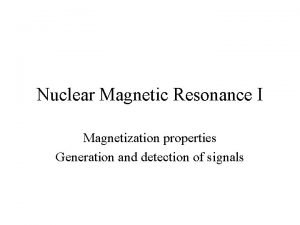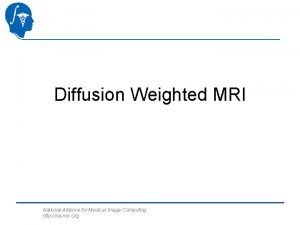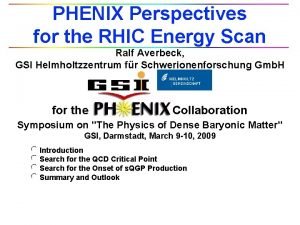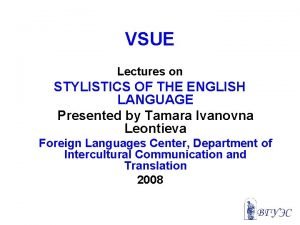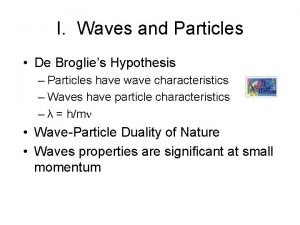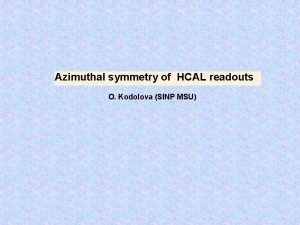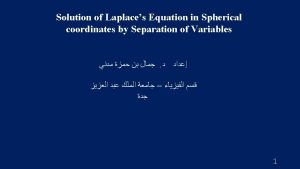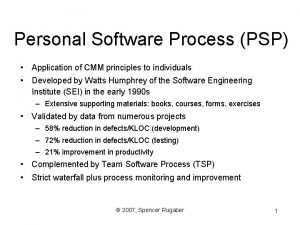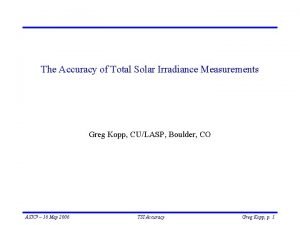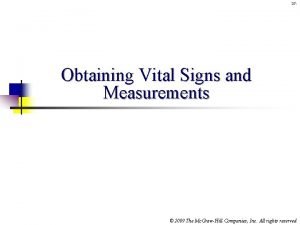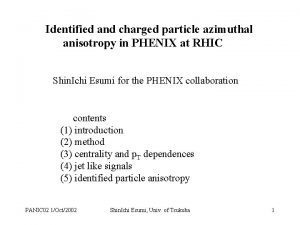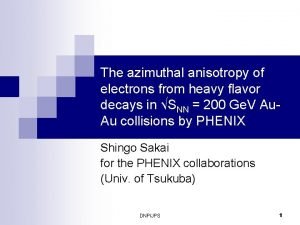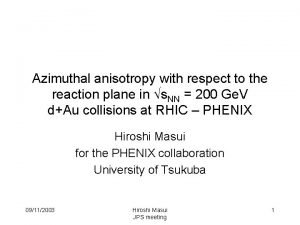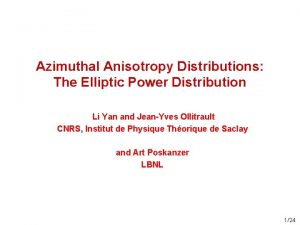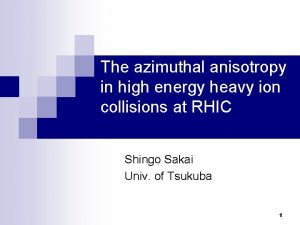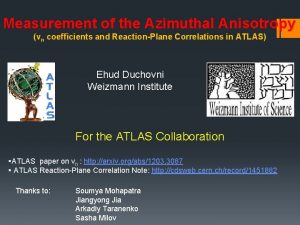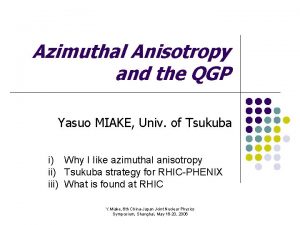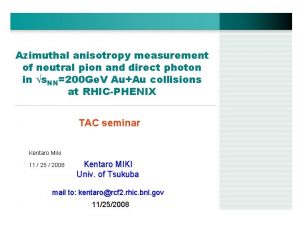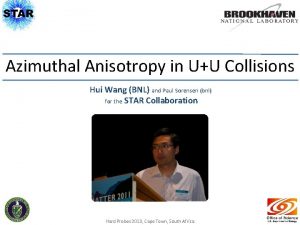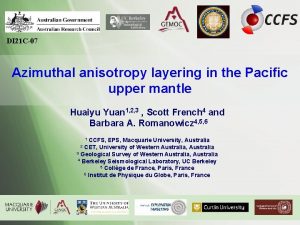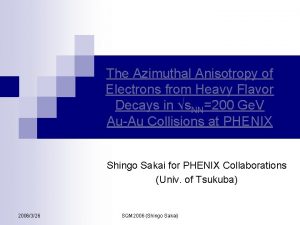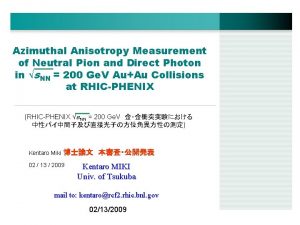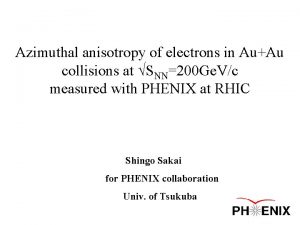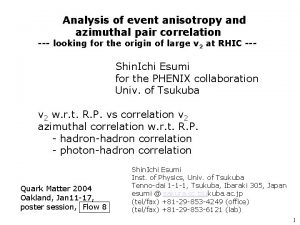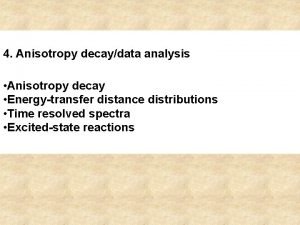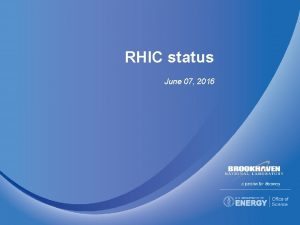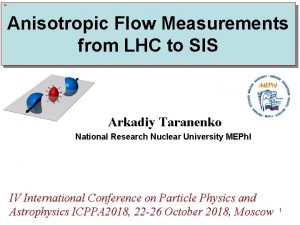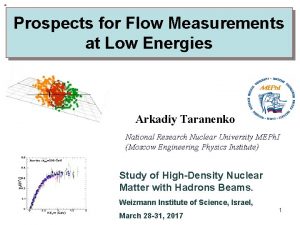PHENIX Measurements of Azimuthal Anisotropy at RHIC Arkadiy
























- Slides: 24

PHENIX Measurements of Azimuthal Anisotropy at RHIC Arkadiy Taranenko National Research Nuclear University MEPh. I (Moscow Engineering Physics Institute) for the PHENIX Collaboration The XXIII International Workshop High Energy Physics and Quantum Field Theory June 26– July 3, 2017 1 Yaroslavl, Russia R. Lacey, SUNY Stony Brook

Azimuthal Anisotropy Measurements at PHENIX 1) Motivation 2) Methods : Vn measurements in PHENIX 3) System size dependence of anisotropy in small systems 4) PID Vn results in small systems at RHIC 5) Beam energy scan for d+Au collisions at RHIC 6) Summary ε 2 ε 3 ε 4 2 R. Lacey, SUNY Stony Brook

The QGP Discovered at RHIC: 2005 -2006 M. Roirdan and W. Zajc, Scientific American, May 2006 3 R. Lacey, SUNY Stony Brook

Anisotropic Flow in Heavy-Ion Collisions - methods CMS 1201. 3158 Different methods, non-flow, fluctuations 4 R. Lacey, SUNY Stony Brook

Anisotropic Flow in HIC at RHIC: results n=2 for mesons and n=3 for baryons Gale, Jeon, et al. , Phys. Rev. Lett. 110, 012302 5 Po. S 2006 (2006) 021 Phys. Rev. C. 93. 051902(R) R. Lacey, SUNY Stony Brook

Collectivity in Small Colliding Systems? Hadronization Pre-equillibrium QGP? Initial state Quark Gluon Plasma? Hadronic phase and freezeout Final state interactions: Hydrodynamic Flow? Initial momentum correlations: CGC? How to distinguish initial vs final state effects ? 6 PLB 718 (2013) 795 PRL 115 (2015) 012301 PLB 726 (2013) 164 R. Lacey, SUNY Stony Brook

PHENIX Experiment at RHIC ZDC |η|>5. 9 MPC/MPC-EX/ 7 7 R. Lacey, SUNY Stony Brook

PHENIX Flow Measurements : Methods Central Arms (CA) |η’| < 0. 35 (particle detection) ψn RXN (|h|=1. 0~2. 8) MPC (|h|=3. 1~3. 7) BBC (|h|=3. 1~3. 9) From 2012: - FVTX (1. 0<|h|<3) Correlate hadrons in central Arms Ø ∆φ correlation function for EPN - EPS with event plane (RXN, etc) (II) (I) Ø∆φ correlation function for EP - CA 8 R. Lacey, SUNY Stony Brook

PHENIX Flow Measurements : Methods Vn (EP): Phys. Rev. Lett. 107 (2011) 252301 Phys. Rev. Lett. 105, 062301 (2010) ØGood agreement between Vn results obtained by event plane (EP) and twoparticle correlation method (2 PC) ØNo evidence for significant η-dependent non-flow contributions from di-jets for p. T=0. 3 -3. 5 Ge. V/c. Systematic p. T=0. 3 -3. 5 Ge. V/c. uncertainty : event plane: 2 -5% for v 2 and 5 -12% for v 3. ψn RXN (|h|=1. 0~2. 8) MPC (|h|=3. 1~3. 7) BBC (|h|=3. 1~3. 9) 9 R. Lacey, SUNY Stony Brook

Small system program at RHIC p. Al p. Au d. Au He. Au Geometry Scan 0 -5% p+Au 0 -5% d+Au 0 -5% He+Au 2 0. 23 0. 54 0. 50 3 0. 16 0. 19 0. 28 Different initial geometry different final state particle emission for p+Au, d+Au and 3 He+Au collisions 10

Small system program at RHIC p. Al d. Au p. Au d. Au 200 Ge. V He. Au Geometry Scan Beam Energy Scan d. Au 39 Ge. V (BES) will help us to search for the turning off the QGP signatures 0 -5% p+Au 0 -5% d+Au 0 -5% He+Au 2 0. 23 0. 54 0. 50 3 0. 16 0. 19 0. 28 Energy Scan d. Au 62. 4 Ge. V d. Au 19. 6 Ge. V 11

Ridge in small systems ( 200 Ge. V) 12 The near side long-range angular correlation (“ridge”) is observed in small systems for high multiplicity d+Au and 3 He+Au events

Estimating Non-Flow Estimation of Non-Flow c 2 (p. T) = c 2 Non-Elementary + c 2 Elementary c 2 (p. T) = c 2 Non-Elementary + c 2 p+p x Charge at Forward h in p+p Charge at Forward h in p+Au v 2: 7% in 3 He+Au, 10% in d+Au; 25% in p+Au increases in smaller systems v 3 : 15% in 3 He+Au cited as a systematic uncertainty 13 13 R. Lacey, SUNY Stony Brook

Vn in small systems ( 200 Ge. V) v 2(3 He. Au) ~ v 2(d. Au) > v 2(p. Au) ~ v 2(p. Al( v 33)He. Au) > v 3)d. Au( Hierarchy compatible with initial geometry + final 14 state effects

Comparison with viscous hydro calculations Hydro without preflow (SONIC) Hydro with preflow (super Better describes the data SONIC) over estimates v 3 and v 2 15

Identified particles v 2 • A clear mass ordering is seen in d/3 He+Au collision while not in p+Au • A stronger radial flow in d/3 He+Au? 16

Identified particle v 2 comparison with hydro p+Au d+Au 3 He+Au • Well described p/d/3 He+Au results at low p. T • Smaller mass split for v 2 in p+Au is predicted • High p. T data are not reproduced - recombination not included 17

Number of Quark Scaling in central 3 He+Au The familiar behavior of number of quark scaling observed in Au+Au collisions is also seen in the small 3 He+Au system 18

V 2 vs collision energy in d+Au 1. The v 2 in 62. 4 and 200 Ge. V d. Au collisions are very similar 2. At lower collision energy, the v 2 increase at high p. T which may due to large non-flow

V 2 vs collision energy in Au+Au 10 -20 % 30 -40 % 20 -30 % 40 -50 %

Comparison with viscous Hydro. Both SONIC and super SONIC calculations are lower than measurements at lower collision energies. It further indicates the large non-flow

√s dependence of c 2{4} at RHIC n n Surprising features: v 2{4} larger at lower √s, reaching v 2{2}. Difficult to describe in both CGC and hydro Important to understand non-flow in standard cumulant method 22

Summary • By scanning different colliding systems PHENIX found that the initial geometry play an important roles for the ridge and vn in small systems. And these results can be well described by the viscous hydro calculations. RHIC geometry scan suggest ordering of vn follows that of εn. • The mass ordering, NCQ scaling and four particles cumulant results indicate a collective behavior in small systems • The v 2 has been measure in small system from 200 Ge. V to 19. 6 Ge. V by event plane method, but nonflow effect need to be further studied • v 2{4} larger at lower √s, reaching v 2{2}.

Backup Slides 24 R. Lacey, SUNY Stony Brook
 Rhic ags users meeting 2020
Rhic ags users meeting 2020 Rhic
Rhic Orbital revolution
Orbital revolution Rhic brookhaven
Rhic brookhaven Fractional anisotropy meaning
Fractional anisotropy meaning Larmor frequency formula
Larmor frequency formula Fractional anisotropy meaning
Fractional anisotropy meaning Etchant
Etchant Crystalline solid and amorphous solid
Crystalline solid and amorphous solid Phenix scan
Phenix scan Phenix scan
Phenix scan Jargonisms are
Jargonisms are Jargonisms
Jargonisms Azimuthal quantum number
Azimuthal quantum number De broglie hypothesis
De broglie hypothesis Hcal jobs
Hcal jobs Laplacian in spherical coordinates
Laplacian in spherical coordinates Azimuthal quantum number
Azimuthal quantum number Dot density map definition ap human geography
Dot density map definition ap human geography Genesis 6 16
Genesis 6 16 4 types of physiological measurements
4 types of physiological measurements Psp model in software engineering
Psp model in software engineering Measurements
Measurements Mathematical literacy measurements grade 12
Mathematical literacy measurements grade 12 Vital signs and body measurements
Vital signs and body measurements


